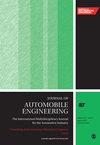基于材料选择方法和隐式参数建模的多材料车身结构轻量化设计
IF 1.5
4区 工程技术
Q3 ENGINEERING, MECHANICAL
Proceedings of the Institution of Mechanical Engineers Part D-Journal of Automobile Engineering
Pub Date : 2024-05-31
DOI:10.1177/09544070241249206
引用次数: 0
摘要
多材料汽车结构可以在每个结构中精确选择材料,从而在降低成本的同时提高产品性能,实现轻量化设计目标。本文介绍了在设计多材料轻质汽车车身时进行材料选择的创新方法。所提出的方法整合了拓扑优化、熵权(EW)和理想解相似度排序偏好技术(TOPSIS),可战略性地在特定位置应用最佳材料。研究以一辆紧凑型电动汽车的车身为中心,利用拓扑优化确定结构内的载荷传递路径和材料分布。EW-TOPSIS 方法为材料引入了一种全面的机械性能排名方法,组织了各种材料的评分标准。通过拓扑优化将这些信息与元素密度相结合,建立了车身性能与材料特性之间的匹配标准和相应关系。随后,利用 SFE-CONCEPT 软件根据材料分布特征生成车身结构的隐式参数模型。车身结构可靠性优化设计的步骤包括建立多目标优化模型、定义和筛选设计变量、分析近似模型和误差,以及基于第二代遗传算法进行可靠性优化。优化后的车身结构经过重构,质量降低了 3.49%,弯曲刚度提高了 38.8%,扭转刚度提高了 6.47%,碰撞安全性能显著提高。本文章由计算机程序翻译,如有差异,请以英文原文为准。
Lightweight design of multi-material body structure based on material selection method and implicit parametric modeling
Multi-material automotive structures enable precise material selection in each structure, leading to enhanced product performance at a reduced cost and achieving lightweight design objectives. This paper introduces an innovative method for material selection in the context of designing multi-material lightweight automotive bodies. The proposed approach integrates topology optimization, Entropy Weight (EW), and the Technique for Order Preference by Similarity to Ideal Solution (TOPSIS) to apply optimal materials in specific locations strategically. The investigation centers on the body of a compact electric vehicle, leveraging topology optimization to ascertain load transfer paths and material distribution within the structure. The EW-TOPSIS method introduces a comprehensive mechanical property ranking method for materials, organizing scoring criteria across various materials. By combining this information with element density via topology optimization, a matching criterion and a corresponding relationship between vehicle body performance and material characteristics are established. Subsequently, the SFE-CONCEPT software is employed to generate an implicit parametric model of the body structure based on material distribution characteristics. The steps of the vehicle body structure reliability optimization design involve establishing a multi-objective optimization model, defining and screening design variables, analyzing the approximate model and errors, and conducting reliability optimization based on a second-generation genetic algorithm. After optimization, the body structure is reconstructed, resulting in a 3.49% reduction in mass, a 38.8% increase in bending stiffness, a 6.47% increase in torsional stiffness, and significantly enhanced collision safety performance.
求助全文
通过发布文献求助,成功后即可免费获取论文全文。
去求助
来源期刊

CiteScore
4.40
自引率
17.60%
发文量
263
审稿时长
3.5 months
期刊介绍:
The Journal of Automobile Engineering is an established, high quality multi-disciplinary journal which publishes the very best peer-reviewed science and engineering in the field.
 求助内容:
求助内容: 应助结果提醒方式:
应助结果提醒方式:


